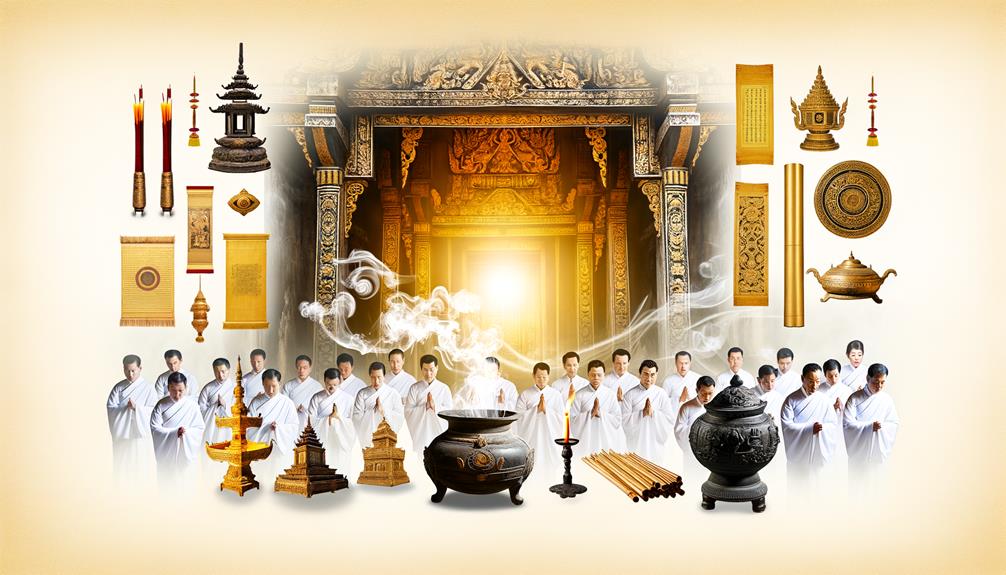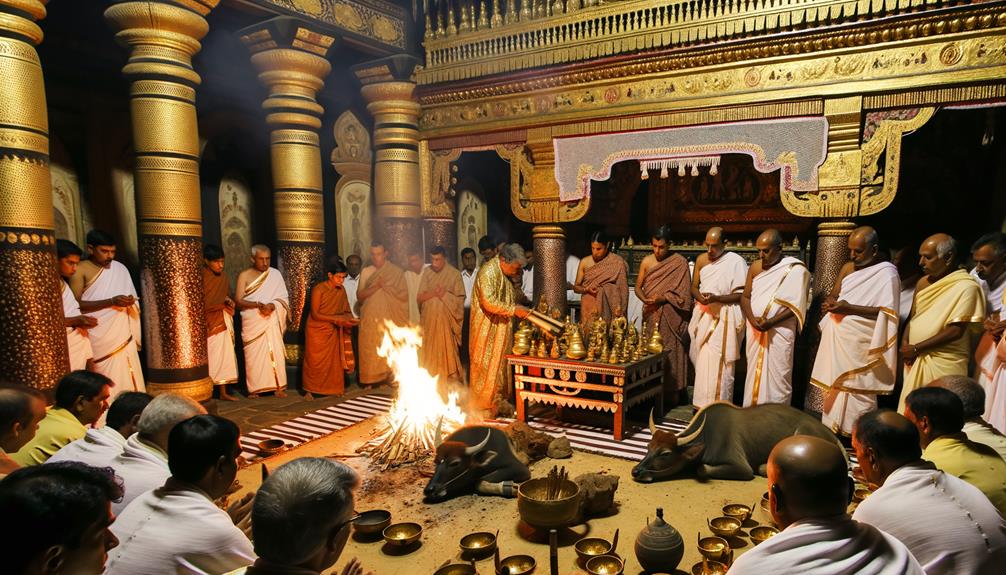Leviticus Meaning in the Bible: Holiness and Law
Leviticus, the third book of the Bible, is pivotal for understanding the ancient Israelite framework of holiness, ritual purity, and ethical conduct. Written during the post-Exilic period, it aimed to re-establish Israel’s identity and practices, emphasizing the importance of adhering to divine laws.
The book is meticulously structured, detailing various offerings, priestly duties, purity laws, and ethical instructions. Central themes include maintaining holiness and societal harmony through specific rituals and behavioral guidelines.
Each ordinance delineates the relationship between the Israelites and their deity, shaping communal and individual life. To explore Leviticus further, one can comprehend its enduring influence on religious practices and ethical systems.

Leviticus Meaning in the Bible: Holiness, Law, and Worship Instructions
| Book | Leviticus |
|---|---|
| Biblical Placement | 3rd book of the Old Testament and the Torah |
| Hebrew Name | Vayikra – “And He called” |
| Main Themes | Holiness, sacrifice, purity laws, priesthood, and covenant |
| Purpose | To instruct Israel on how to live as God’s holy people |
| Key Phrase | “Be holy, for I am holy” (Leviticus 11:44) |
| Spiritual Insight | Highlights God’s desire for purity, order in worship, and covenantal obedience |
Historical Context

Situated within the broader narrative of the Pentateuch, Leviticus serves as an essential text for understanding the religious, cultural, and legal frameworks of ancient Israelite society.
Compiled during the post-Exilic period, Leviticus reflects a time when Israelites sought to re-establish their identity and religious practices after the Babylonian exile.
It emphasizes ritual purity, holiness, and ethical conduct, underpinning societal cohesion and divine favor.
The text’s regulations and ordinances, ranging from sacrificial rituals to moral laws, were instrumental in shaping communal and individual behavior.
Structure of Leviticus

The book of Leviticus is meticulously organized into distinct sections that each address specific aspects of Israelite worship, ethical conduct, and community regulations.
The introductory chapters (1-7) detail various offerings, including burnt, grain, and peace offerings. Chapters 8-10 describe the consecration of priests, emphasizing the importance of ritual purity.
Subsequent chapters (11-15) elaborate on purity laws, particularly regarding food, diseases, and bodily discharges.
The central chapter, 16, outlines the Day of Atonement, a pivotal ritual for communal atonement.
Following this, chapters 17-26, often referred to as the Holiness Code, present moral and ethical laws, while chapter 27 concludes with regulations on vows and tithes.
This structure underscores the thorough nature of Levitical law.
Themes of Holiness

At the heart of Leviticus lies the pervasive theme of holiness, intricately woven throughout its detailed prescriptions for religious practice and communal life.
The concept of holiness in Leviticus emphasizes separation from impurity and alignment with divine standards. This theme is manifest in various laws and codes governing moral conduct, dietary restrictions, and social interactions.
Holiness is not merely an abstract ideal but a practical guide for maintaining purity and sanctity in daily living. By adhering to these divine commandments, the Israelites were set apart as a holy nation dedicated to God.
Consequently, holiness in Leviticus serves as a foundational principle that shapes the identity and ethical framework of the community, underscoring their covenantal relationship with the divine.
Rituals and Sacrifices

The book of Leviticus meticulously outlines various types of offerings, including burnt, grain, peace, sin, and guilt offerings, each serving distinct purposes in the worship and atonement processes.
In addition, it provides detailed information on the duties of priests, emphasizing their essential role in mediating between the Israelites and God.
Moreover, the significance of purification rituals is highlighted, underscoring their importance in maintaining ritual purity and community holiness.
Types of Offerings
Leviticus meticulously categorizes various types of offerings, each serving distinct purposes within the framework of ancient Israelite worship practices.
The principal offerings include the Burnt Offering (Olah), symbolizing complete devotion to God, and the Grain Offering (Minchah), representing gratitude for divine provision.
The Peace Offering (Zevach Shelamim) fosters communal harmony and thanksgiving. The Sin Offering (Chatat) and Guilt Offering (Asham) address atonement for unintentional sins and specific transgressions, respectively.
Each offering is characterized by specific procedures, ingredients, and intentions, reflecting the multifaceted relationship between the Israelites and their deity.
These rituals are integral in maintaining covenantal fidelity, communal purity, and spiritual alignment with divine commandments, underscoring Leviticus’ role in the theological and social fabric of ancient Israel.
Priestly Duties Explained
Priestly duties in ancient Israelite society encompassed a complex array of rituals and sacrifices, meticulously detailed to guarantee adherence to divine mandates and the maintenance of communal sanctity.
These responsibilities, primarily delineated in the Book of Leviticus, included the offering of burnt, grain, peace, sin, and guilt sacrifices, each with specific procedural requirements.
Priests served as intermediaries between the people and God, ensuring that sacrifices were performed correctly to atone for sins, seek blessings, or express gratitude.
Detailed instructions outlined how to handle sacrificial animals, the proper use of the altar, and the precise burning of offerings.
Such rituals were essential for maintaining the covenant relationship between God and the Israelite community, reflecting a structured approach to worship and obedience.
Purification Rituals Significance
In ancient Israelite tradition, purification rituals held profound significance as they meticulously delineated the processes required to restore individuals and the community to a state of ritual purity, thereby ensuring ongoing compliance with divine ordinances.
These rituals often involved specific sacrifices and ceremonies to cleanse both physical and spiritual impurities. Purification was essential for maintaining the sanctity of the community and facilitating an uninterrupted relationship with the divine.
| Ritual Type | Purpose | Elements Involved |
|---|---|---|
| Sin Offering | Atonement for unintentional sins | Animal sacrifice, sprinkling |
| Purification Rites | Cleansing from physical impurities | Water, ashes, ceremonial acts |
| Guilt Offering | Restitution and guilt removal | Ram sacrifice, restitution |
These rituals underscored the importance of holiness and adherence to God’s laws.
Purity Laws

Purity laws, encompassing a wide array of regulations concerning ritual cleanliness and uncleanliness, form an essential component of the Levitical code and reflect the ancient Israelites’ profound concern with maintaining holiness in their community.
These laws delineate specific conditions under which individuals could become ritually impure, such as through contact with certain animals, bodily discharges, or corpses. The procedures for regaining purity often involved washing, waiting periods, and offerings.
By establishing clear boundaries between the sacred and the profane, these purity laws aimed to preserve the sanctity required for worship and communal living.
The meticulous observance of these laws underscored the Israelites’ commitment to a lifestyle that honored their covenantal relationship with God, ensuring communal and individual sanctification.
Ethical Instructions

Leviticus provides a thorough framework for ethical behavior, emphasizing both moral purity laws and social justice guidelines.
These instructions are designed to cultivate a community characterized by righteousness and equity, reflecting the holiness of God.
Through these directives, the text underscores the importance of ethical conduct in maintaining societal harmony and divine favor.
Moral Purity Laws
While the book of Leviticus is often associated with ritualistic and ceremonial laws, its moral purity laws provide a detailed framework for ethical conduct that emphasizes the importance of justice, compassion, and integrity in the community.
These laws explore various aspects of daily life, addressing issues such as honesty in business transactions (Leviticus 19:35-36), the prohibition of theft and deceit (Leviticus 19:11), and the need to treat others with respect (Leviticus 19:18).
By focusing on these ethical guidelines, Leviticus underscores the necessity for individuals to uphold moral standards that promote societal harmony and righteousness.
The emphasis on ethical behavior reflects a broader divine mandate for the Israelites to embody holiness in their interactions and relationships.
Social Justice Guidelines
Building upon the foundation of moral purity laws, the social justice guidelines in Leviticus provide thorough instructions aimed at fostering equity and compassion within the community.
These guidelines encompass various ethical instructions, such as fair treatment of workers (Leviticus 19:13), equitable business practices (Leviticus 19:35-36), and provisions for the poor and marginalized (Leviticus 19:9-10).
The text emphasizes justice and righteousness, advocating for honest dealings and prohibiting exploitation.
In addition, it calls for periodic debt forgiveness and the release of slaves during the Jubilee year (Leviticus 25).
These directives serve to create a balanced societal structure, ensuring that all members of the community are treated with dignity and respect, reflecting the overarching principle of loving one’s neighbor as oneself.
Priestly Roles

The priestly roles delineated in Leviticus are central to understanding the religious and social structure of ancient Israelite society. Priests served as mediators between God and the people, ensuring adherence to divine laws. Their responsibilities included:
- Sacrificial Duties: Priests performed various sacrifices to atone for sins, express gratitude, and maintain communal purity.
- Ritual Purity: They supervised and enforced laws regarding cleanliness and holiness, preventing defilement within the community.
- Instructional Roles: Priests educated the Israelites on the statutes and ordinances, guiding them in righteous living.
These roles underscored the importance of maintaining a sanctified relationship with God, emphasizing the need for ritualistic precision and moral integrity.
Understanding these duties helps elucidate the societal and religious norms of that era.
Relevance Today

Examining the contemporary relevance of Leviticus reveals its enduring impact on modern religious practices and ethical frameworks.
Leviticus, with its detailed laws and rituals, continues to shape Jewish and Christian liturgical traditions, underscoring the importance of purity, atonement, and holiness.
Its ethical guidelines, particularly those addressing social justice and community welfare, resonate today, influencing discussions on morality and communal responsibility.
Additionally, Leviticus’s emphasis on dietary laws and health regulations finds parallels in contemporary movements advocating for mindful eating and holistic health.
While some aspects may seem culturally distant, the underlying principles of reverence, discipline, and ethical living maintain their significance, offering timeless wisdom applicable to both personal conduct and societal norms.
Conclusion
The examination of Leviticus within its historical context, structured composition, and diverse themes underscores its pivotal role in the biblical canon.
The text’s emphasis on holiness, intricate rituals, and stringent purity laws delineates a thorough framework for ethical and religious conduct.
Additionally, the delineation of priestly roles further accentuates its theological significance.
Despite its ancient origins, Leviticus continues to offer profound insights into contemporary religious practices, ethical considerations, and communal identity, making its study relevant and enduring.






